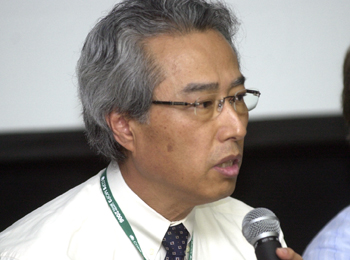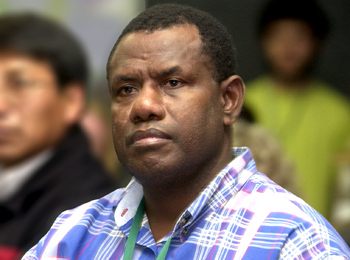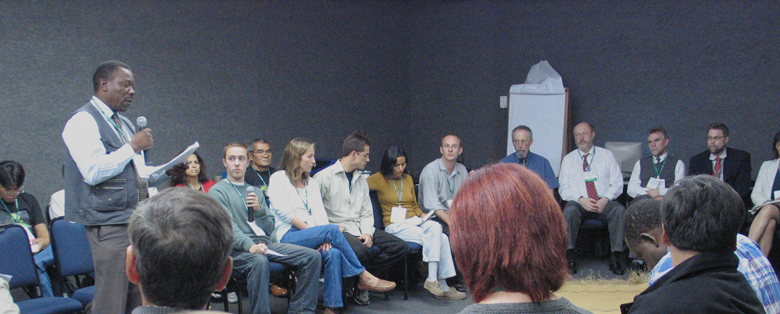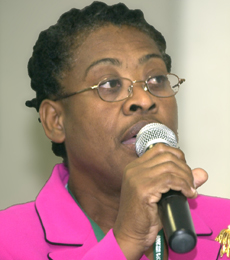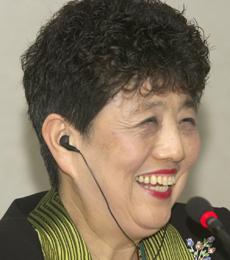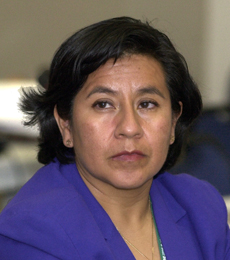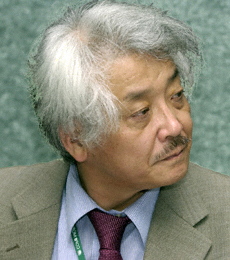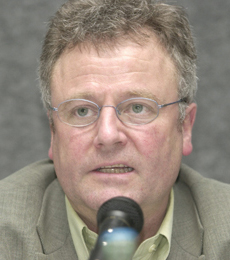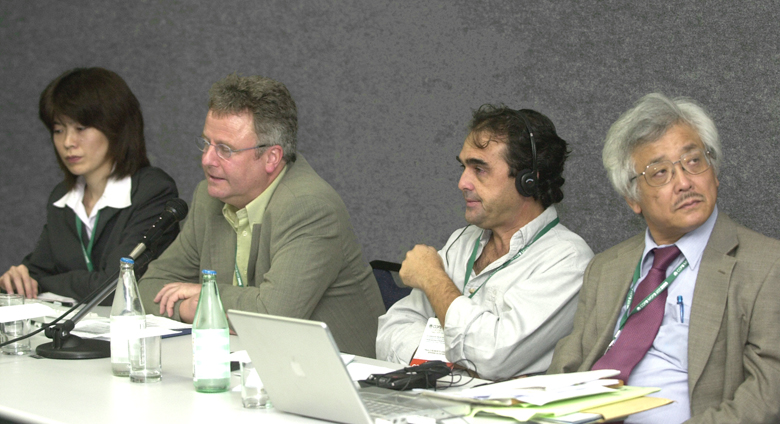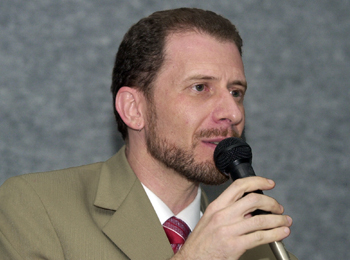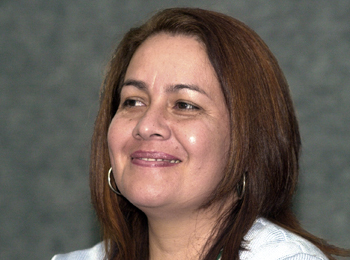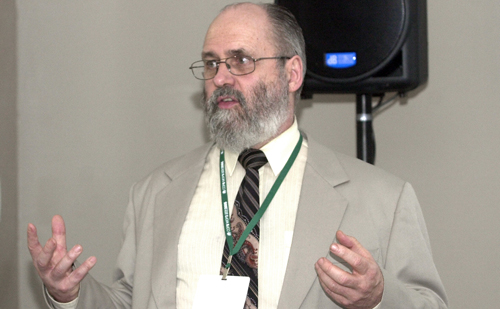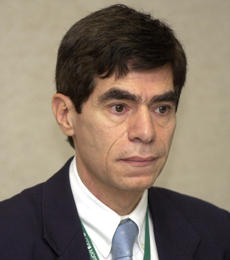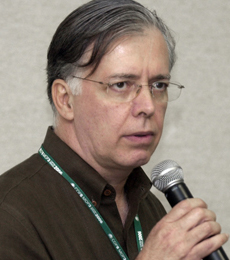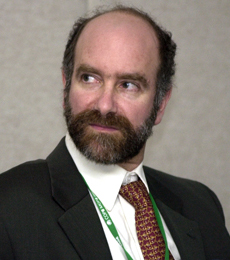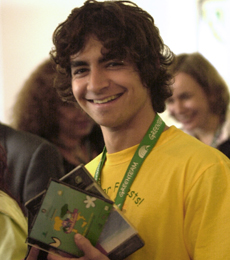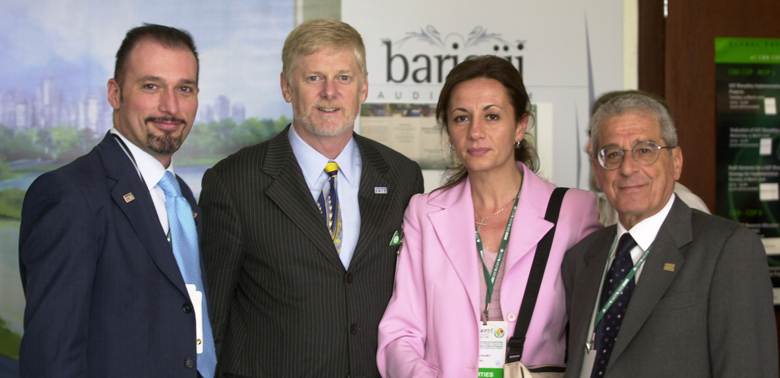 |
||
|
published by IISD, the International Institute for Sustainable Development
in cooperation with the CBD Secretariat |
|||
|
A Special Report on Selected Side Events at CBD COP-8
|
|||||
| 20-31 March 2006 | Curitiba, Brazil | |||||
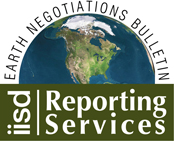 |
 |
||||
 |
|||||
|
United Kingdom Foreign & Commonwealth Office
|
|||||
Events convened on Wednesday, 29 March 2006
|
Local-Global Leaders Dialogue Presented by the Equator Initiative and the Community Taba |
|||
|
This event enabled local and global leaders to engage in informal discussions regarding how they can work together to conserve biodiversity while addressing development needs. Livingstone Maluleke, Makuleke Traditional Community, South Africa, stated that traditional ownership of lands must be recognized, and that communities and their knowledge of the natural environment must be completely integrated in conservation. Isabel Soares de Souza, Institute of Sustainable Development, Mamirauá, encouraged the integration of local and global networks, and suggested that different forms of knowledge can compliment each other. William Atu, The Nature Conservancy, Solomon Islands, noted that very little of the CBD has been implemented, and noted also the need for an ABS regime to prevent injustice. Vitaliano Sarabia, Union of Rural Cocoa Organizations of Ecuador (UNOCACE), encouraged compromise from all sectors, and the empowerment of small communities, the “guardians of biodiversity.” Willy Kostka, Executive Director, Micronesia Conservation Trust, encouraged making funding easier to access, and called for private companies to reinvest profits into the communities from which they are obtained. John Herity, IUCN, urged community leaders to push national governments to enact policies conducive to community action in support of conservation and development. Manifred Niekisch, Germany, said that while biodiversity is the basis of life, justice is the basis of reasonable living. Joachim Flasbarth, Federal Ministry for the Environment, Nature Conservation and Nuclear Safety, Germany, noted that communicating the messages that have emerged from the Taba depends on local leaders, and not professional marketing. He stressed that the message must be kept simple, adding that “at the end of the day, if I can’t explain to my daughters what I do, this is the wrong approach.” Jock Langford, Environment Canada, noted the recent international gathering of indigenous people, hosted by the Tsleil-Waututh Nation in Vancouver, Canada, which resulted in the drafting of a statement which was presented to CBD COP 8. Viveka Bohn, Environmental Ambassador, Sweden, said that democracy and equality are fundamental with far-reaching consequences in addition to the CBD. Regarding improving participation, she suggested that people look to successes achieved within the Millennium Ecosystem Assessment and international chemicals management processes. Shoji Nishimoto, UNDP, noted that many micro-credit schemes have failed while attempting to adopt approaches more suitable to urban areas. He noted that it is not always in the best interest of small communities to be integrated into the global economy. Brett Jenks, Rare Conservation, urged building upon success stories, identifying markets, and understanding what each local community's competitive advantage is within the market. |
|||
|
|||
|
Medicinal Plants and Herbal Medicine: the Pan-American Experience Presented by the National Association of Sanitary Surveillance (ANVISA) and the Brazilian Ministry of Health |
||||
|
Norberto Rech, ANVISA, Brazil, welcomed participants to the second working group of the Pan American Network for Drug Regulatory Authority Harmonization. Xiaorui Zhang, WHO, noted the close link between medicinal plants, biodiversity and sustainable use of resources, and emphasized the need to consider appropriate methodologies to ensure public health. She outlined activities of various regional and international working groups currently cooperating in scientific research and considering harmonized standards and regulations for herbal medicine, one being the WHO initiative on International Regulatory Cooperation on Herbal Medicines. Rosario d’Alessio, Pan-American Health Organization (OPAS), noted the importance of the OPAS Guidelines which address the differences between countries in terms of medicinal plants and herbal medicine. Ana Ruth Gutierrez Poveda, Ministry of Health Risks, Bolivia, outlined progress in medicinal plant and herbal medicine regulation in Bolivia, noting: registration for production and sale of herbal medicines whether produced traditionally or by industrial means; ensuring access to herbal medicine for remote communities; and the regulation of prices. Princess Thomas Osbourne, Ministry of Health, Jamaica, noted the rapid introduction to markets of new, unfamiliar medicinal plants from local and natural sources in dosage forms not necessarily regulated. She argued for harmonized regulation of practitioners and herbal products and emphasized the need for scientific information on many of the herbs used. Rosaliá Reyes Pérez, Federal Commission for the Protection against Health Risks, Mexico, noted problems in medicinal certification where no generic naming system and taxonomies exist between countries, emphasizing the importance of scientific research data and compliance mechanisms. |
||||
|
|||
|
Conservation of Satoyama (Traditional Rural Landscape) Experience from Ishikawa, Japan and Paraná, Brazil Presented by United Nations University (UNU) and Ishikawa International Cooperation Research Centre |
||
|
Alphonse Kambu, UNU, explained that Satoyama consists of four major ecosystems: agricultural, forest, grassland and wetland. Highlighting the values of Satoyama, he mentioned provision of ecosystem services, habitat for biodiversity and traditional knowledge. He noted that 40% of Satoyama are in decline, threatened with loss of biodiversity and cultural heritage, adding that these threats are due in part to the aging population and the impact of rural-urban migration.
Henke Simons, the Netherlands Committee for IUCN, discussed ecosystem services which he defined as the benefits that people obtain from: provisioning services (food, fiber and fresh water); regulation services (regulation of ecosystems processes like climate, disease and floodes); and cultural services (spiritual, recreational and aesthetic benefits). He said that biodiversity is fundamental for the functioning of ecosystems which are required to provide these services. Paulo Roberto Castella, Secretary of the Environment, Paraná, discussed Sistema Faxinal no Paraná, a traditional forest management system in Paraná, explaining that the settlement is divided into criadouro comum, an area where livestock are kept; terras de planta, where cultivation occurs; and cercas, fences which demarcate these areas, and are vital for the functioning of the forest system. He highlighted challenges such as the growing population, land degradation and high land costs, mentioning that only 42 of 144 original forest systems remain in the State of Paraná. |
||
|
|||
|
Strategy for the Conservation and Sustainable Use of Biological Diversity for MERCORSUR Presented by Secretariat of Environment and Sustainable Development National Coordination Sub Working Group No. 6 Argentina |
||||
|
On Wednesday evening, 29 March, MERCOSUR representatives endorsed a common strategy developed for the conservation and sustainable use of the region's biodiversity, including Atílio Savino, Ministry of Health and Environment, Argentina; Claudio Langone, Ministry of Environment, Brazil; Mirta Medina, Ministry of Environment, Paraguay; Víctor Cantón, Ministry of Environment, Uruguay; and Ricardo Sánchez, UNEP, Regional Office for Latin America. Presenting an overview of the MERCOSUR Biodiversity Strategy up to 2010, Homero M. Bibiloni, Ministry of Environment and Sustainable Development, Argentina, indicated the need for a common strategy emerging from priority themes such as environmental goods and services, and the management of transboundary natural areas. Bibiloni noted that the strategy recognizes socio-cultural diversity, and stressed that conservation and sustainable use should aim at achieving poverty reduction and the Millennium Development Goals, emphasizing mechanisms to ensure fair and equitable sharing of benefits arising out of utilization of genetic resources, traditional knowledge, innovations and practices. Bibiloni indicated that the Strategy has seven basic elements with clear objectives. These include: knowledge and information sharing; conservation; sustainable use of biodiversity components; monitoring, evaluation, prevention and mitigation of biodiversity loss; access to genetic resources, traditional knowledge and benefit-sharing; communication, education and public awareness; and institutional strengthening, governance and judicial arrangements. While countries recognize that biodiversity plays a key role in the maintenance of human well-being, Bibiloni stressed that they expect the MERCOSUR Biodiversity Strategy to be a step forward in the regional integration process of policies and actions. |
||||
|
|||
|
Preliminary Results from the International Expert Workshop on Criteria for Identifying Ecologically or Biologically Significant Areas Beyond National Jurisdiction Presented by the Government of Canada |
||
|
Jake Rice, Fisheries and Oceans, Canada, explained that the report emanates from the Ad Hoc Working Group for Protected Areas in Montecatini in 2005, which called for criteria to review, assess and develop a set of scientifically rigorous ecological criteria that could be used to identify potential sites for marine protected areas beyond the limits of national jurisdiction. He added that the rationale was that these areas merit the use of a higher-than-normal level of precaution in their management and protection. Rice stressed that the report focuses on scientific aspects to be used as criteria while acknowledging that science does not function in a vacuum and is subject to governance and other implementation issues.
Rice elaborated on the scientific criteria for identifying ecologically or biologically significant areas. These included: uniqueness or rarity, areas where few alternatives exist and could be significantly harmed; habitats used for critical life history functions; vulnerability, areas highly susceptible to degradation; ecological productivity; and biological diversity and naturalness. The last criteria mentioned was representativeness. He explained that as long as an acceptable proportion of “representative” areas receive enhanced management, choices can be made regarding which ones to manage in particularly risk-averse ways, and ones which can be managed in a way that is less restrictive yet still sustainable. Rice also discussed considerations in the use of scientific criteria including management feasibility; anthropogenic value and implementation consideration. |
||
|
|||
|
Biodiversity and Human Health Presented by the World Health Organization (WHO) |
||
|
Carlos Corvalán, WHO, noted how essential ecosystem services are to health in key areas, providing: food supplies, fisheries and livestock; water purification and coastal protection by wetlands; energy and fuel; mitigation of climate change; regulation of infectious diseases; and provision of medicinal products through genetic resources, traditional knowledge and biotechnology. Corvalán noted that dependence on solid fuels for cooking and heating in unventilated areas causes an average of 1.6 million deaths per year, with women and children being the most affected.
Ulisses Confalonieri, Oswaldo Cruz Foundation (FIOCRUZ), discussed the main findings from the Millennium Ecosystem Assessment (MA), stressing that the spread of disease due to ecosystem changes depends on the particular ecosystem, type of land use change, disease-specific transmission dynamics, and the susceptibility of human populations, making generalization very difficult from site to site. Confalonieri noted inherent trade-offs in many types of ecosystems' changes associated with economic development, where the costs of disease emergence or resurgence must be weighed against a project’s benefit to human well-being and health. Jonathan Patz, Center for Sustainability and the Global Environment, University of Wisconsin, stressed that health is at the heart of the Rio Conventions, noting that climate change leads to extreme weather events, malnutrition, water, food- and vector-borne diseases; biodiversity degradation affecting nutritional changes, disease regulation, medicinal products, and water purification; and desertification which leads to water scarcity, population displacement, droughts, and food scarcity. Patz highlighted three important dimensions for sustainability: social justice (equitable distribution, distributed consumption), a vibrant economy (investment in sustainable technologies, providing services) and a healthy environment. |
||
|
|||
|
ITALIAN DIRECTOR GENERAL DR. ALDO COSENTINO GREETS KIDS FOR FORESTS, AND PRESENTS THEM WITH EDUCATIONAL CD-ROMS ON ITALIAN PROTECTED AREAS |
||
|
||
|
Click the above button to go back to our ENB main coverage
|
||
|
|
|
|
|
||
|
